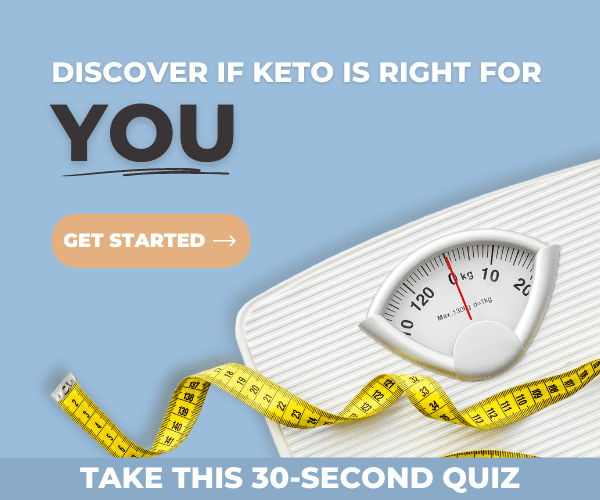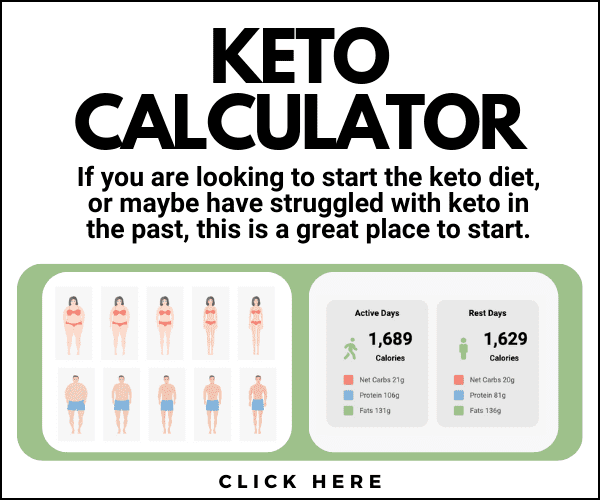
The Atkins diet picked up steam in the 70s and 80s and is still popular today. If you’ve heard of it, you probably know that it’s a low carb diet. Of course, the ketogenic diet also relies on limiting carbs. So what’s the difference between keto and Atkins? There are a lot of similarities as well as some stark differences between the two. Let’s compare keto vs. Atkins to see how they stack up to each other.
What Is the Ketogenic Diet?
Ketogenic diets involve low carbohydrate, moderate protein, and high-fat consumption. Instead of using carbs and sugar for fuel, a keto diet forces your body to burn fat, and trains it to do so more efficiently. Following a ketogenic diet has been proven to improve various health conditions as well as help you lose weight. [1]
With keto, you don’t just lower your carbohydrate intake of grains, potatoes, and other starchy foods; you also increase your intake of healthy fats, such as fish, nuts, and avocado. With your carb intake dropping, typically below 20-50 grams of net carbs daily, your body enters the metabolic state called ketosis, where you become more efficient in burning fat for fuel.
What Can I Eat on a Ketogenic Diet?
On a ketogenic diet, the focus is on the following:
- Pastured eggs
- Poultry and grass-fed meats (bacon, ham, steak, etc.)
- Avocados
- Full-fat butter, cream, and cheese
- Other healthy fats and oils, such as olive oil and coconut oil
- Low-starch veggies, such as broccoli, peppers, mushrooms, and leafy greens
- Nut butter
- Cocoa and unsweetened dark chocolate
- Wild-caught fish and seafood
- Full-fat dairy
- Nuts and seeds
You can also have seasonings that don’t contain added sugars, such as salt, pepper, spices, herbs, and low-carb condiments such as mustard and hot sauce.
Limit or avoid the following foods on keto:
- Traditional grains and refined grain products, such as bread and baked goods
- Sugary foods and drinks like ice cream and soda
- Most beans or legumes, such as kidney beans and peas
- Starchy tubers and vegetables, such as white potatoes
- Certain fruits
- High-sugar sauces like commercial BBQ sauce
- Certain alcoholic beverages
You can consume berries and other low-glycemic fruits in moderation.
What Is the Atkins Diet?
The Atkins diet is a low-carb diet created in the 1960s by heart specialist Robert Atkins, who recognized the many troubles that can arise from a diet high in carbohydrates. Atkins has evolved into several plans, but the original version (Atkins 20) is the most popular.
Atkins was originally designed for weight loss and involved a four-step plan where you gradually increase your carb allowance over time as you lose weight. Similar to the ketogenic diet, on Atkins, you can eat an abundance of fat and protein as long as you count your carbs. Remember, to calculate net carbs, you take your total carbs minus the fiber and sugar alcohols.

Induction Phase
You consume under 20 grams of net carbs daily during the induction phase of the Atkins diet until you’re within 15 pounds of your weight loss goal. You’re in ketosis during the induction phase. Eat high-fat, high-protein meals with low-carb veggies like leafy greens. Acceptable drinks on Atkins include water, coffee, and green tea.
Phase 2
You increase your carb consumption to 25-50 grams of net carbs daily until you’re within 10 pounds of your desired weight. You can start adding in more low-carb veggies, nuts, and small amounts of lower-carb fruits. Most people are also typically in ketosis during this second phase.
Phase 3
To shed the last 10 pounds, you increase carb intake to 50-80 grams of net carbs a day until you achieve your weight loss goal and maintain your goal weight for at least one month. This phase leaves ketosis behind, but stays relatively low carb.
Phase 4
After maintaining your goal weight for one month, you can consume as many healthy carbs as you feel you can tolerate, up to 100 grams of net carbs per day. You remain in phase 4 indefinitely to maintain your goal weight. While the end goal of this diet is to leave ketosis, it’s still a fairly low-carbohydrate diet compared to the standard American diet. On the standard American diet, Americans obtain around 50% of their daily calories from carbs, which is around 250 grams of carbs if you eat 2,000 calories daily. [2]
Keto Vs. Atkins: What’s the Difference?

Below, we’ll break down the biggest similarities and differences between keto and Atkins. Keep in mind that if you have questions or concerns about your diet or wellness, it’s best to visit your doctor, healthcare practitioner, or a qualified dietitian or nutritionist.
Similarities
The central theme of lowering your carbohydrate intake prevails in both diets. Whether you’re following a general ketogenic or Atkins diet, you’ll need to say goodbye to high-carb food groups like whole grains, starchy veggies like potatoes, and sugary drinks and desserts. The first two phases of the Atkins eating plan are essentially keto (and in fact should put you in the metabolic state of ketosis) because you’ll be restricting your net carbs to less than 50 grams daily.
Both Atkins and the ketogenic diet are backed by strong research showing they’re effective for weight loss. [3] [4]
Keto and Atkins both:
- Are low-carb
- Place your body into ketosis (only during phases 1 and 2 of Atkins)
- Promote weight loss
- Restrict refined carbohydrates and sugary products
Differences
If you’ve read the up to this point in this article, you’ll know there are a number of distinct differences between keto and Atkins.
- A ketogenic diet is used not just for weight loss but also therapeutically for a range of health disorders, from Alzheimer’s to arthritis and cancer. Atkins is designed only for weight loss.
- A ketogenic diet is renowned for stabilizing blood sugar. Research shows Atkins is also helpful for controlling blood sugar, but it isn’t quite as effective as keto, which has allowed many people to get off their diabetes medication entirely. [5] [6]
- Going keto keeps you in ketosis as long as you follow the diet, whereas on the third phase and the maintenance phase of Atkins, you’ll shift out of ketosis and consume a moderately low-carb diet. While the Atkins diet initially reaps the benefits of ketosis, the focus is on weight loss rather than ketones.
- The later phases of Atkins have a more flexible carb limit, which allows those on it to consume a wider variety of foods, including some grains and a wider variety of veggies and fruits.
- An average keto diet is only around 20-25% protein. Depending on the type, Atkins allows 30% or an abundance of fat and protein.
- Keto dieters may monitor ketones or macronutrients to stay in ketosis, which isn’t ever a focus on the Atkins diet. Atkins focuses on counting your carbs and transitioning through the four phases.
- Most ketogenic diets limit or restrict processed foods, whereas Atkins allows you to eat processed foods. In fact, there’s a line of Atkins brand bars, protein shakes, and more.
Promising studies show the possible benefits of both Atkins and the ketogenic diet, and which one you choose will depend on your goals and what is sustainable for you. For those looking to reap the therapeutic benefits of keto, such as reducing the symptoms of diabetes, stabilizing blood sugar, improving epilepsy symptoms, or improving autism symptoms, keto is a great choice. Keto is also an excellent choice for weight loss and staying in ketosis can be a good way for those who have achieved their goal weight to maintain it.
However, while some people find ketosis to be sustainable long-term, the ketogenic diet isn’t the right choice for everyone. People who are looking for a diet rather than a lifestyle change tend to follow Atkins for a certain time period to achieve specific weight loss goals.
References
Freeman, J. M., Kossoff, E. H., & Hartman, A. L. (2007). The ketogenic diet: One decade later. Pediatrics, DOI: 10.1542/peds.2006-2447
Cohen, E., Cragg, M., DeFonseka, J., Hite, A., Rosenberg, M., & Zhou, B. (2015). Statistical review of US macronutrient consumption data, 1965-2011: Americans have been following dietary guidelines, coincident with the rise in obesity. Nutrition, DOI: 10.1016/j.nut.2015.02.007
Bueno, N. B., De Melo, I. S. V., De Oliveira, S. L., & Ataide, T. R., (2013). Very-low-carbohydrate ketogenic diet v. low-fat diet for long-term weight loss: A meta-analysis of randomised controlled trials. British Journal of Nutrition, DOI: 10.1017/S0007114513000548
Gardner, C. D., Kiazand, A., Alhassan, S., Kim, S., Stafford, R. S., Balise, R. R., Kraemer, H. C., & King, A. C. (2007). Comparison of the Atkins, Zone, Ornish, and LEARN diets for change in weight and related risk factors among overweight premenopausal women: the A TO Z weight loss study: A randomized trial. JAMA, DOI: 10.1001/jama.297.9.969
Krebs, J. D., Bell, D., Hall, R., Parry-Strong, A., Dochety, P. D., Clarke, K., & Chase, J. G. (2013). Improvements in glucose metabolism and insulin sensitivity with a low-carbohydrate diet in obese patients with type 2 diabetes. Journal of the American College of Nutrition, DOI: 10.1080/07315724.2013.767630
Yancy, Jr. W. S., Foy, M., Chalecki, A. M., Vernon, M. C., & Westman, E. C. (2005). A low-carbohydrate ketogenic diet to treat type 2 diabetes. Nutr Metab (London), DOI: 10.1186/1743-7075-2-34










